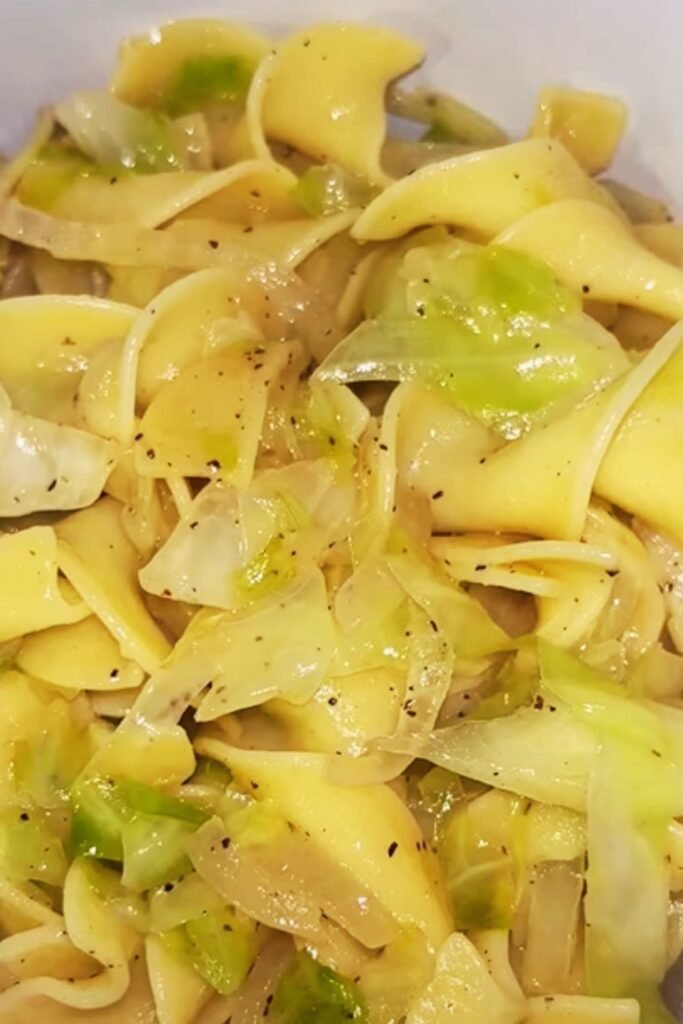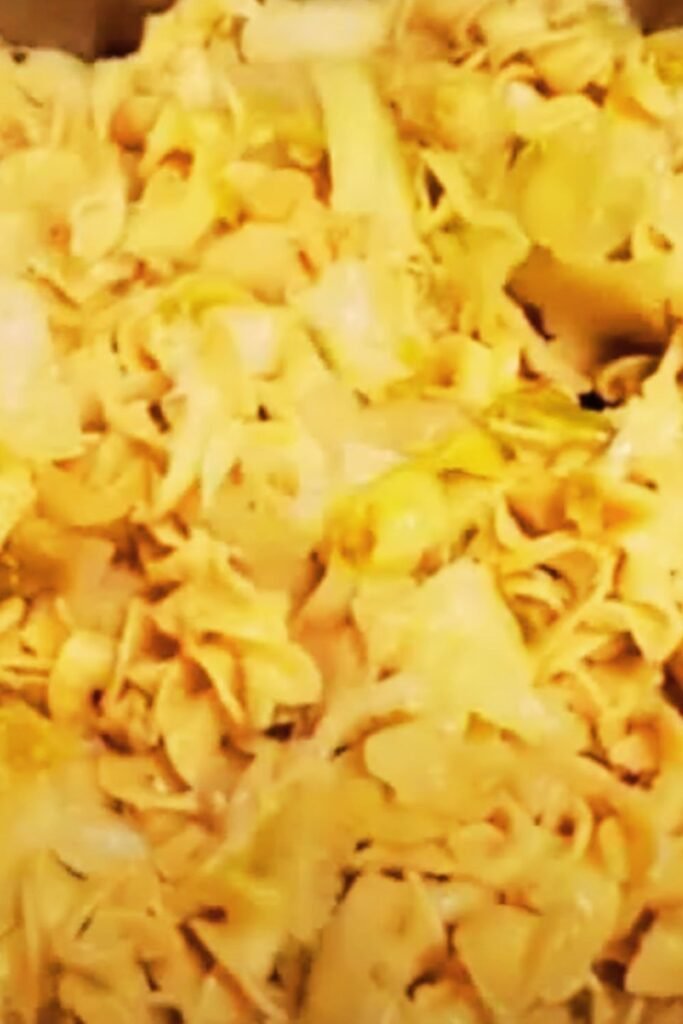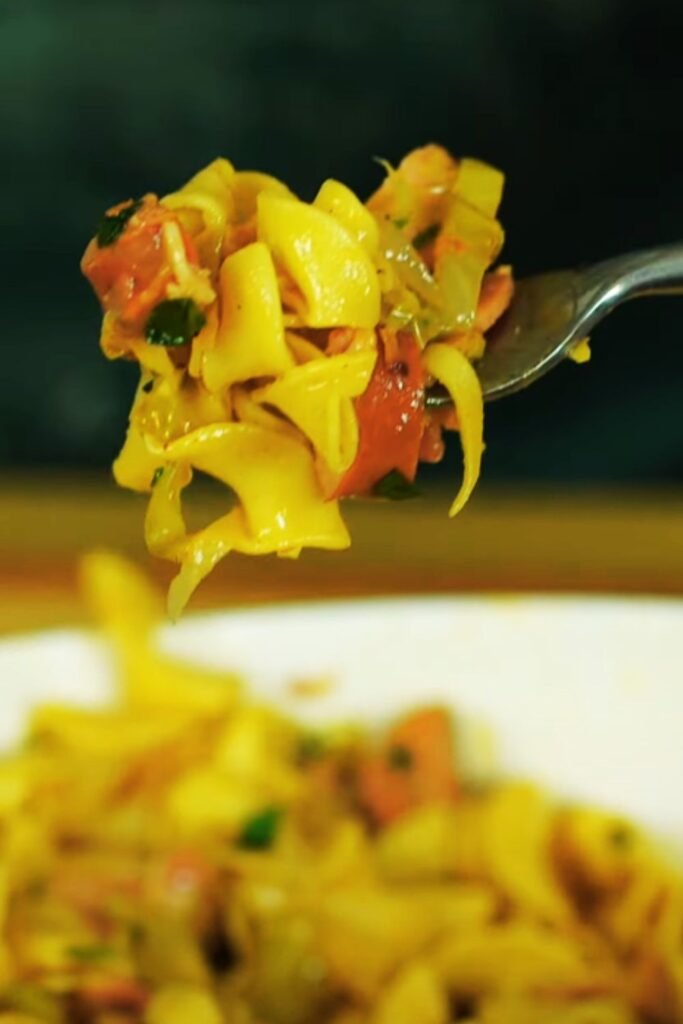When the autumn winds start blowing and I crave something warm and satisfying, my mind immediately turns to haluski. This humble yet incredibly comforting dish has been gracing tables across Eastern Europe and Polish-American households for generations. I’ve been making this recipe for over a decade, and it never fails to bring warmth to both my kitchen and my heart.
Haluski represents more than just a meal – it’s a testament to the beautiful simplicity of peasant cooking. With just a handful of ingredients, you can create something that feels like a warm hug on a plate. I remember the first time my grandmother showed me how to make this dish, emphasizing that the secret wasn’t in fancy techniques or expensive ingredients, but in patience and love.
What Exactly Is Haluski?
Haluski is a traditional Eastern European comfort food dish consisting primarily of egg noodles, cabbage, and onions sautéed together with butter or oil. The name itself comes from the Slovak word “halušky,” though variations exist across Polish, Ukrainian, and Hungarian cuisines.
Comfort Food in this context refers to dishes that provide nostalgic or sentimental value, often associated with childhood memories and family traditions.
Peasant Cuisine describes simple, hearty dishes made from readily available, inexpensive ingredients that were traditionally prepared by working-class families.
The beauty of haluski lies in its versatility and forgiving nature. Unlike delicate French sauces or precise baking recipes, this dish welcomes improvisation and adapts beautifully to whatever you have on hand.
My Personal Connection to This Recipe
I first encountered haluski during a particularly challenging winter when money was tight, and I needed meals that would stretch both my budget and my family’s appetites. A Polish neighbor, Mrs. Kowalski, knocked on my door with a steaming bowl of what looked like the most unassuming dish I’d ever seen. One bite, and I was completely hooked.
The combination of sweet, caramelized cabbage with tender egg noodles created a symphony of textures and flavors that I hadn’t expected. Mrs. Kowalski spent the next afternoon teaching me her family’s recipe, passed down from her great-grandmother in Krakow. Since then, I’ve made countless variations, each one teaching me something new about this remarkable dish.

Essential Ingredients Breakdown
Let me walk you through each component that makes haluski special:
| Ingredient | Purpose | Best Options | Substitutions |
|---|---|---|---|
| Egg Noodles | Base carbohydrate, provides heartiness | Wide egg noodles, pappardelle | Fusilli, rotini, even spaetzle |
| Cabbage | Primary vegetable, adds sweetness when caramelized | Green cabbage (firm heads) | Savoy cabbage, napa cabbage |
| Yellow Onions | Aromatic base, adds depth | Large yellow onions | Sweet onions, white onions |
| Butter | Fat for cooking, richness | Unsalted European-style | Olive oil, bacon fat |
| Salt | Seasoning | Kosher salt or sea salt | Table salt (use less) |
| Black Pepper | Spice | Freshly ground | Pre-ground (less potent) |
| Paprika | Color and mild flavor | Hungarian sweet paprika | Smoked paprika for depth |
Choosing the Right Cabbage
Not all cabbages are created equal for haluski. I’ve learned through trial and error that a firm, dense head of green cabbage works best. When you tap it, you should hear a hollow sound, and the outer leaves should be crisp and vibrant. Avoid cabbages with brown spots or leaves that feel limp – they won’t caramelize properly and can make your dish soggy.
The Noodle Decision
While traditional recipes call for wide egg noodles, I’ve experimented with various pasta shapes over the years. The key is choosing something that will hold onto the cabbage and onion mixture. Wide, flat noodles like pappardelle or fettuccine work wonderfully, but even rotini or fusilli can create interesting texture combinations.
Step-by-Step Cooking Process
Preparation Phase (15 minutes)
Before I touch the stove, I always get everything prepped. This dish moves quickly once you start cooking, and having everything ready prevents any burnt cabbage disasters.
Noodle Preparation:
- Bring a large pot of salted water to boil
- Use about 1 tablespoon of salt per quart of water
- Cook noodles until just shy of al dente (they’ll finish cooking in the pan)
Vegetable Preparation:
- Remove outer leaves from cabbage and discard
- Cut cabbage into quarters, remove core
- Slice into thin strips, about ¼-inch wide
- Slice onions into half-moons, maintaining uniform thickness

The Cooking Magic (25-30 minutes)
This is where the transformation happens. I heat my largest skillet over medium heat and add butter. The key temperature indicator I use is when the butter stops foaming but hasn’t started browning – that’s your sweet spot.
First Stage – Building the Base:
- Add sliced onions to the butter
- Cook for 5-7 minutes until they start becoming translucent
- Sprinkle with a pinch of salt to help draw out moisture
- Stir occasionally to prevent sticking
Second Stage – Adding the Cabbage:
- Add all the cabbage to the pan (it will seem like too much, but it will cook down dramatically)
- Season with salt and pepper
- Stir to combine with onions
- Let it cook undisturbed for 3-4 minutes to start caramelization
Third Stage – The Patient Game: This is where many people go wrong. They rush the process. I’ve learned that patience here makes all the difference. Continue cooking for 15-20 minutes, stirring every 3-4 minutes. You’ll watch the cabbage transform from bright green to golden, then to a beautiful caramelized brown.
Final Stage – Bringing It Together:
- Add drained noodles to the cabbage mixture
- Toss everything together gently
- Add a pat of butter for extra richness
- Season with paprika and adjust salt and pepper to taste
Nutritional Information and Health Benefits
| Nutrient | Per Serving (1 cup) | Daily Value % |
|---|---|---|
| Calories | 285 | 14% |
| Carbohydrates | 42g | 14% |
| Protein | 8g | 16% |
| Fat | 10g | 15% |
| Fiber | 4g | 16% |
| Vitamin C | 45mg | 50% |
| Vitamin K | 85mcg | 71% |
| Folate | 65mcg | 16% |
| Iron | 2.1mg | 12% |
Cabbage is genuinely a nutritional powerhouse that I feel good about serving my family. It’s loaded with vitamin C – actually containing more per serving than oranges – and provides significant vitamin K for bone health. The fiber content helps with digestion and keeps you feeling satisfied longer.
Recipe Variations I’ve Perfected
Polish-Style Haluski with Kielbasa
This is my go-to variation when I want something more substantial:
- Add 8 oz sliced kielbasa during the onion cooking phase
- Let the sausage brown slightly before adding cabbage
- The rendered fat adds incredible flavor depth
Vegetarian Mushroom Haluski
Perfect for meatless Monday dinners:
- Sauté 8 oz mixed mushrooms (cremini, shiitake, oyster) with the onions
- Add fresh thyme and a splash of white wine vinegar
- Finish with fresh parsley
Bacon Lover’s Version
For special occasions when calories don’t count:
- Cook 6 strips of bacon until crispy, remove and chop
- Use bacon fat instead of butter for cooking
- Sprinkle bacon pieces on top before serving

Storage and Meal Prep Strategies
| Storage Method | Duration | Best Practices | Reheating Tips |
|---|---|---|---|
| Refrigerator | 3-4 days | Airtight container, cool completely first | Add splash of water, reheat gently |
| Freezer | 2-3 months | Portion in freezer bags, remove air | Thaw overnight, reheat with butter |
| Meal Prep | 4-5 days | Separate containers, don’t overfill | Microwave 1-2 minutes, stir halfway |
I’ve found that haluski actually improves after a day in the refrigerator. The flavors meld together beautifully, and reheating it with a little extra butter brings back that fresh-cooked texture.
Troubleshooting Common Problems
Problem: Soggy Cabbage Solution: This usually happens when the heat is too low or you’re not patient enough with the caramelization process. Make sure your pan is hot enough that you hear sizzling when you add vegetables.
Problem: Burnt Cabbage Solution: Heat too high or not stirring frequently enough. Lower the temperature and add a splash of water to deglaze if needed.
Problem: Bland Flavor Solution: Not enough salt during cooking, or added too late. Season in layers – a little with the onions, more with the cabbage, and adjust at the end.
Problem: Mushy Noodles Solution: Overcooked the pasta initially, or cooked it too long with the cabbage. Undercook pasta slightly when boiling, as it will continue cooking in the pan.
Serving Suggestions and Pairings
I’ve served haluski in countless ways over the years, and here are my favorite combinations:
As a Main Dish:
- Serve with a dollop of sour cream and fresh dill
- Pair with crusty rye bread and butter
- Add a simple cucumber salad with vinegar dressing
As a Side Dish:
- Excellent alongside roasted chicken or pork tenderloin
- Perfect with grilled bratwurst or other sausages
- Complements beef stew beautifully
Garnish Options:
- Fresh chopped parsley or dill
- A sprinkle of caraway seeds
- Toasted breadcrumbs for extra texture
- Grated sharp cheese (though not traditional)
Cultural Significance and Family Traditions
Haluski represents something profound in Eastern European culture – the ability to create something deeply satisfying from simple ingredients. In many Polish and Slovak families, the recipe for haluski is passed down through generations, with each cook adding their personal touch.
I’ve learned that in some regions, haluski is considered a celebration dish, prepared for harvest festivals and family gatherings. The communal aspect of preparing large batches brings families together, with everyone taking turns stirring the massive pots of caramelizing cabbage.
The dish also represents resourcefulness and frugality – qualities highly valued in immigrant communities. When more expensive ingredients were scarce, families could still create a filling, nutritious meal that satisfied both hunger and the soul.
Shopping Tips and Ingredient Selection
At the Grocery Store:
- Choose cabbage heads that feel heavy for their size
- Look for bright green outer leaves without brown spots
- Select onions that are firm with papery, intact skins
- Buy egg noodles from the refrigerated section when possible
Seasonal Considerations:
- Fall and winter cabbages tend to be sweeter and more flavorful
- Spring cabbages are milder and cook faster
- Summer onions are often stronger, so use slightly less
Budget-Friendly Tips:
- Cabbage is typically cheaper when bought whole rather than pre-cut
- Stock up on egg noodles when they’re on sale – they keep well
- Yellow onions are usually more economical than sweet varieties
Advanced Techniques for Perfect Haluski
The Caramelization Sweet Spot
After years of making this dish, I’ve identified the exact moment when cabbage reaches perfect caramelization. The edges will be golden brown, and you’ll hear a gentle sizzling that becomes more intermittent. The aroma shifts from sharp and vegetable-like to sweet and nutty. This transformation typically takes 18-22 minutes at medium heat.
Temperature Control Mastery
I use what I call the “water drop test” to gauge pan temperature. A small drop of water should sizzle immediately but not violently when the pan is ready. If it just sits there, the pan needs more heat. If it bounces and evaporates instantly, it’s too hot.
Layering Flavors
Professional chefs talk about building flavors in layers, and haluski is perfect for practicing this technique. I season lightly at each stage rather than dumping all the salt in at once. This creates depth and complexity that seasoning only at the end can’t achieve.
Questions and Answers
Q: Can I make haluski ahead of time for a dinner party?
I absolutely make haluski ahead for entertaining! The flavors actually improve after sitting for a few hours. I prepare everything up to the point of adding the noodles, then reheat the cabbage mixture and add freshly cooked pasta just before serving. This method ensures the noodles don’t get overcooked or mushy.
Q: What’s the best way to cut cabbage for even cooking?
My technique involves quartering the cabbage first, then removing the tough core from each quarter. I slice each quarter into strips roughly ¼-inch wide, cutting from the top of the quarter down to where the core was. This creates uniform pieces that cook evenly and maintain some texture even after caramelization.
Q: Can I substitute other vegetables for cabbage?
While cabbage is traditional, I’ve experimented with Brussels sprouts (halved), leeks, and even fennel. Brussels sprouts work particularly well – they caramelize beautifully and add a slightly different flavor profile. Use about the same quantity, but they’ll cook a bit faster than cabbage.
Q: Why does my haluski turn out watery sometimes?
Watery haluski usually results from not cooking the cabbage long enough to evaporate its natural moisture, or from adding the pasta when it’s still too wet. Make sure to drain your noodles thoroughly, and don’t be afraid to let that cabbage cook until it’s properly caramelized. The moisture will evaporate, concentrating the flavors.
Q: Is there a gluten-free version of this dish?
Absolutely! I’ve made excellent haluski using gluten-free pasta, rice noodles, or even spiralized zucchini noodles. The key is adjusting cooking times – gluten-free pasta often needs a shorter cooking time with the cabbage to prevent mushiness. Rice noodles work particularly well and absorb the flavors beautifully.
Q: How do I prevent the onions from burning while waiting for the cabbage to caramelize?
This is a common challenge I faced when learning the dish. The trick is to add the cabbage before the onions are fully caramelized. They’ll continue cooking together, and the moisture from the cabbage actually helps prevent burning. If you notice any sticking, add a tablespoon of water to deglaze the pan.
Q: Can I freeze leftover haluski?
Yes, but with some caveats. The texture changes slightly after freezing – the noodles can become a bit softer. I freeze it in individual portions and add a splash of cream or butter when reheating to help restore some richness. It’s best consumed within 2-3 months of freezing.
Q: What’s the difference between haluski and other cabbage and noodle dishes?
Haluski is distinguished by its simplicity and the level of caramelization achieved with the cabbage. Unlike some Asian cabbage and noodle dishes that might include soy sauce or other complex seasonings, traditional haluski relies on the natural sweetness developed through proper caramelization, enhanced only by salt, pepper, and sometimes paprika.
Creating the perfect bowl of haluski has become one of my greatest cooking pleasures. It’s taught me patience, the value of simple ingredients, and how technique can transform the ordinary into something extraordinary. Every time I make it, I’m reminded of Mrs. Kowalski’s kitchen and the generous spirit that introduced me to this wonderful dish.
The beauty of haluski lies not just in its comforting flavors, but in its ability to bring people together around the table. Whether you’re cooking for family, friends, or just treating yourself to a satisfying meal, this dish delivers warmth, nourishment, and a connection to generations of home cooks who understood that the best food doesn’t need to be complicated – it just needs to be made with care.